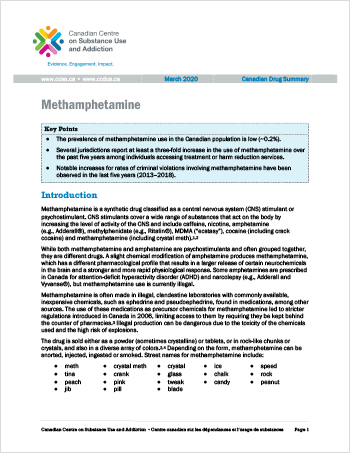

How Does Meth Affect the Brain?Meth is neurotoxic. Unfortunately, these are exactly the effects that make many people abuse methamphetamine as a performance-enhancing drug. Street Names: crystal, meth, crystal meth, speed, crank, ice, chalk, scootie, glass, tick-tick, yellow barn, redneck cocaineThe flood of dopamine in the body triggers short-term effects like increased wakefulness and attention and decreased fatigue. Other items that could be left behind after meth abuse are small pieces of crumpled aluminum foil, soda cans with a hole in the side or the shafts of inexpensive ball-point pens that might be used to snort the drug.While some versions of methamphetamine are still used for medicinal purposes, crystal meth is illegal and extremely addictive as well as highly dangerous. If you are looking for traces of meth use, therefore, you may find small bags of white powder or crystals or syringes. Methamphetamine properly refers to a specific chemical substance, the racemic free base, which is an equal mixture ofMethamphetamine can be swallowed, snorted, injected or smoked.
Shabu, the variation of the drug in the Philippines, has shown even more serious side effects. Paranoia, hallucinations, and self-absorptionSome psychological, emotional, and behavioral effects of meth abuse hinder the user’s ability to function effectively as a responsible member of society, form and sustain healthy relationships, perform at the workplace, and hold on to jobs. The effects are psychological, cognitive, motor, and behavioral. Chronic drug abuse damages the brain structures and causes chemical changes.
Damage to the nasal pathways, a common effect of snorting the drug Tolerance produces physical, emotional, and chemical dependence on the drug that eventually turns abuse into addiction and causes meth side effects to become more severe.The Long-Term Physiological Methamphetamine Side Effects Are: Damage to the heart, lungs, liver, and kidneysChronic methamphetamine abuse makes the user tolerant to the drug, so he progressively needs more of it to derive the same effect as before. Some meth-induced changes are irreversible and can trigger life-threatening complications.
Increased risk of developing Parkinson’s disease due to reduced dopamine levels Increased risk of stroke due to damage to blood vessels Aggressive or violent and sometimes homicidal behavior stemming from an inability to control impulses Random, repetitive, and compulsive motor activities like twitching or scratching Psychotic symptoms similar to schizophrenia and marked by delusions, paranoia, visual and auditory hallucinations, and self-absorption An aged appearance that is the result of poor diet and hygiene, the presence of various medical conditions, and a stressful lifestyleThe Long-Term Neurological, Psychological, And Behavioral Meth Side Effects Include:
But sometimes, the psychotic effects of meth abuse tend to persist for months after quitting the drug.Methamphetamine users who inject the drug are at a higher risk of contracting certain other diseases, such as hepatitis B and C, AIDS, bacterial infections, inflammation at the site of injection. Structural and functional changes in the brainAbstinence can improve motor and verbal learning abilities in most users. The addictive disorder that manifests as compulsive drug-seeking behavior
Continued use can tear arteries and cause fatal bleeding into the heart. Rupture Of Arteries: Meth is toxic to large blood vessels. Development Of Clots: The drug constricts blood vessels and veins that can lead to the formation of clots. These can lead to heart attacks. Cardiovascular System Damage: Methamphetamine stresses the heart by elevating blood pressure and disturbing its normal rhythmic patterns. Moreover, as high tolerance to the drug may make users take higher doses leading to a methamphetamine overdose.
Most of these elements are highly toxic and damage the kidneys and the lungs.Meth Affects the Kidneys In the Following Ways: Meth can contain toxins like battery acid, lead, drain cleaner, paint thinner, red phosphorus derived from matchsticks, lithium extracted from batteries, and Freon. Continued use increases the user’s risk of developing hepatitis that can progress to cirrhosis or his chances of succumbing to acute liver failure.Drug dealers often lace meth with adulterants and bulking agents to increase their profits.

It constricts blood vessels, and kidneys can shut down due to reduced blood flow.Some of these damages brought on by methamphetamine are irreversible. The backflow of urine can cause kidney failure. Methamphetamine can cause urine retention.
The damage is greater in users who smoke the drug. The presence of toxins in crystal meth damages the lungs directly. Else the person has to undergo dialysis for the rest of his life.Methamphetamine Damages the Lungs In the Following Ways: In some cases, kidney transplantation is required.
It is the inability to find pleasure from things that used to do just that. This is a potentially life-threatening condition marked by breathlessness, chest pain, fatigue, and fainting.Anhedonia Following Crystal Methamphetamine UseAnhedonia is a very challenging side effect of meth use and can lead to other symptoms such as depression and suicidal thoughts. This may cause fluid to accumulate in the lungs. Constricted blood vessels reduce the flow of blood to the lungs. This causes oxidative stress that damages the organ.
This is why addiction treatment programs are so helpful because they teach coping skills to manage those feelings. While searching for feelings of pleasure, he discovers that he is no longer capable of finding it anywhere but in crystal methamphetamine. This can be a major cause of relapse once an addict has detoxed from methamphetamine.



 0 kommentar(er)
0 kommentar(er)
